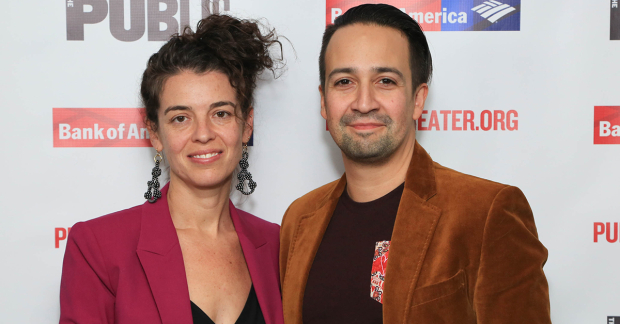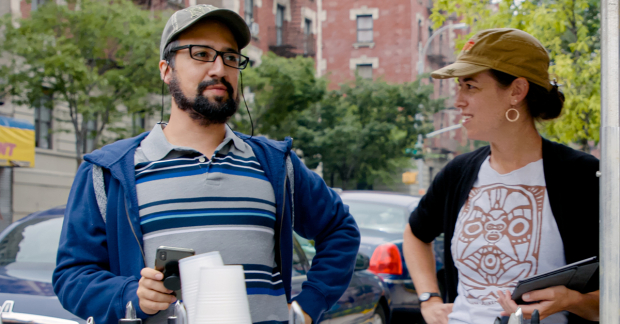Interview: Lin-Manuel Miranda and Quiara Alegría Hudes on How Time Has Deepened In the Heights
The two writers discuss rebuilding their theatrical baby for the big screen.
Everyone who has seen In the Heights remembers the experience. It was like a jolt of electricity exploding out of ancient confines, a game-changing, genre-defying musical that paid loving tribute to its forebears while introducing the world of theater to the new century. It taught Broadway the names of writers Lin-Manuel Miranda and Quiara Alegría Hudes, two future Pulitzer Prize winners (he for Hamilton, she for Water by the Spoonful) and proved that the ever-evolving world of musical-theater was not only alive and well, but kicking.
In the ensuing years since In the Heights ran on Broadway, the Tony-winning musical has become a worldwide sensation. Since its humble beginnings, the history of the show has come full circle — originally a student project cooked up by Miranda at Wesleyan University, it has since become a staple of colleges and high schools, not to mention community groups, around the world.
On June 11, that scope will widen with the release of Jon M. Chu's film adaptation. With age and time comes new wisdom, and Hudes and Miranda teamed up once again to create a version of In the Heights that was reverential of their original stage edition, while speaking to the world of 2021. The result is an In the Heights that is much more mature, but beautifully familiar, and infused with the same vitality as their theatrical creation. Here, they discuss rebuilding their baby for the big screen.

(© Tricia Baron
These conversations have been condensed and edited for clarity.
How does the medium of film open up the world of In the Heights, which on stage is sort of confined to one main location?
Quiara Alegría Hudes: On Broadway, and even in the 37 Arts workshop, there were little subway steps that went up, or, like, a little subway entrance off to the side. That's the subway. But on screen, we weren't confined to a unit set anymore. You can go into the station where the ascent or descent to the platform is so dizzyingly steep and long, and the escalator is broken half the time. If Abuela Claudia is trying to get somewhere, she's taking the stairs. What is it like for her, on the hottest day, as an elderly woman, to traverse 143 stairs? That opened up "Paciencia y Fe," when Abuela Claudia is remembering how punishing some of her early memories in New York were. To have a bigger ensemble, to be closer in on her, to see their facial expressions, and to be able to work more visually was super exciting.
Lin-Manuel Miranda: Full credit to Jon M. Chu, who was always reaching for the version of the song you couldn't do onstage. When we stumbled on the Highbridge Pool and I was like, "Oh yeah, that's where we swim in the summers," he was like "96,000." In the script, it's on a city block, but he dreams bigger for us. For "When the Sun Goes Down," he had the idea of this anti-gravity dance up the side of the building, complete with fire escapes and leaking air conditioners, and in an aside to me, he goes, "I just wish the song were longer, because this is really expensive." So I said, "Well, it can be longer." I already knew that "Sunrise" wasn't going to make sense in the new chronology, so what if the dance climax of "When the Sun Goes Down" is "Sunrise"? I ran to the piano and figured out how to make them sing the lyric "at the same time" and then go into the "Sunrise" motif. He was always pushing towards the more cinematic answer every time.

(© Warner Bros. Entertainment)
What is it like to see In the Heights on the big screen, both in light of the pandemic-related delay, and the fact that this show has been in your lives for such a long time?
Quiara: It brings all the clichés of, like, "dream big," to life. My imagination physically takes up very little space. It's just me. But then you do it, and you follow through on the little details. Like Abuela Claudia says, "Detail by detail, you make a big story." And it's totally wild. I attribute it to Jon Chu, who said, "You did the detail work and now we're going to do the Hollywood work." Because it is a Hollywood story. This merits the big screen. This merits the notion that this is for everyone. He was very insistent on that, so I have to give him props for that.
Lin: I feel lighter. When the shutdown happened, and when we realized that we were not going to be able to release it in the summer of 2020, I felt like we were back at the O'Neill, and Kevin McCollum was telling us that it's not ready yet. It was that feeling of "We're sitting on this thing and we know how proud of it we are, and we just can't wait to get it out of our heads and onto a stage." It was a flashback of that. But I'm really glad we waited. Now, the movie has a double-poignancy, of "remember when we used to sing and dance and hug and kiss in the streets?" It's this love letter from the time before the year-and-a-half we've had.

(© Warner Bros. Entertainment Inc.)
How did looking at this material through the eyes of the older and wiser versions of yourselves impact the changes that you made in the process?
Lin: I just think that Quiara and I are better at this than we were when we were in our 20s. Quiara's screenplay is so smart. It updates the script without losing the essence of the 2008 version and it brings other issues to the floor that are really on the front pages of the Latinx community in the United States right now.
Quiara: I wanted to go even deeper into the character of Nina, for instance, and prop her up more. In the time since the stage play, the way financial aid works at colleges has changed. There's less of an emphasis on student loans and more emphasis on scholarships. That said, students still struggle financially, and there is still student-loss because of financial hardship. But that shift gave me an opportunity to look a little more closely at the cultural frictions that she experiences when she gets to Stanford. In some ways, she was raised very sheltered. She was raised around her community and people who understand the songs she sings, and she gets to Stanford and is sitting in that room and she's like, "Is this space made for me?" She is put into a position where she can build a new Stanford, as many first generations do. The opportunity to dig deeper into that cultural story was very exciting.
Lin: To revisit these characters again was really, really fun, and it's still from this perspective of joy. We wanted to write about our own community with a sense of joy, and that shines through. I'm really proud of these 20s us-es, but also really proud that we had another crack at it.







